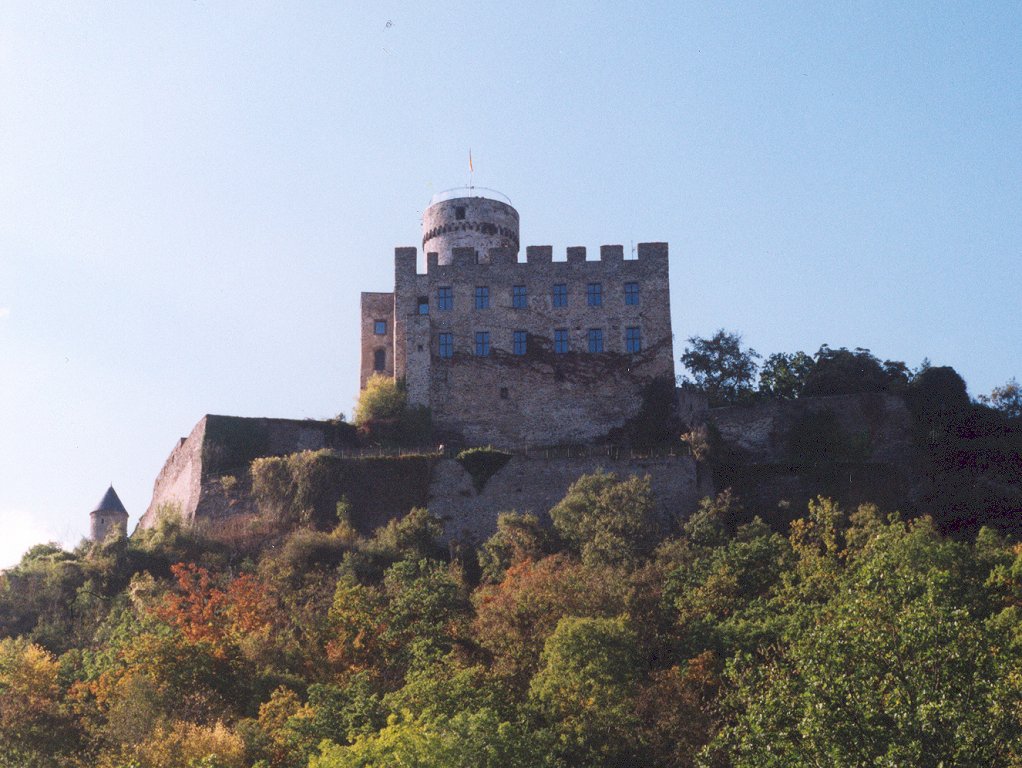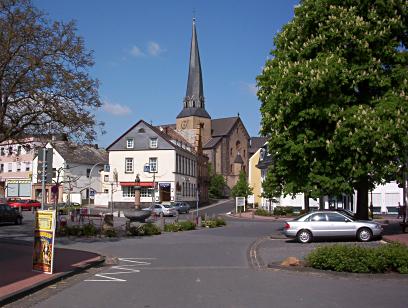|
Brohl
Brohl is an ''Ortsgemeinde'' – a municipality belonging to a ''Verbandsgemeinde'', a kind of collective municipality – in the Cochem-Zell district in Rhineland-Palatinate, Germany. It belongs to the ''Verbandsgemeinde'' of Kaisersesch. Geography Brohl is a small village in the Eifel. Through the municipality flows the Brohlbach, which empties into the Moselle at Karden. Nearby lie Treis-Karden on the Moselle, Münstermaifeld, Polch and Mayen. Neighbouring villages are, among others, Roes, Forst and Kaifenheim. History In 926, Brohl had its first documentary mention as ''Brula'', and was then under the ownership of St. Maximin's Abbey in Trier. The Brohl high court belonged to the ''Pellenzgerichte'' (“Pellenz Courts”), which in 1696 were taken into Electoral-Trier ownership. In 1711, Brohl was granted to the ''Schenk'' (a noble title, historically meaning something akin to “steward”) of Schmidtburg. Beginning in 1794, Brohl lay under French rule. In 1815 it w ... [...More Info...] [...Related Items...] OR: [Wikipedia] [Google] [Baidu] |
Eifel
The Eifel (; lb, Äifel, ) is a low mountain range in western Germany and eastern Belgium. It occupies parts of southwestern North Rhine-Westphalia, northwestern Rhineland-Palatinate and the southern area of the German-speaking Community of Belgium. The Eifel is part of the Rhenish Massif; within its northern portions lies the Eifel National Park. Geography Location The Eifel lies between the cities of Aachen to the north, Trier to the south and Koblenz to the east. It descends in the northeast along a line from Aachen via Düren to Bonn into the Lower Rhine Bay. In the east and south it is bounded by the valleys of the Rhine and the Moselle. To the west it transitions in Belgium and Luxembourg into the geologically related Ardennes and the Luxembourg Ösling. In the north it is limited by the Jülich-Zülpicher Börde. Within Germany it lies within the states of Rhineland-Palatinate and North Rhine-Westphalia; in the Benelux the area of Eupen, St. Vith and Luxemb ... [...More Info...] [...Related Items...] OR: [Wikipedia] [Google] [Baidu] |
Moselle (river)
The Moselle ( , ; german: Mosel ; lb, Musel ) is a river that rises in the Vosges mountains and flows through north-eastern France and Luxembourg to western Germany. It is a bank (geography), left bank tributary of the Rhine, which it joins at Koblenz. A small part of Belgium is in its drainage basin, basin as it includes the Sauer and the Our River, Our. Its lower course "twists and turns its way between Trier and Koblenz along one of Germany's most beautiful river valleys."''Moselle: Holidays in one of Germany's most beautiful river valleys'' at www.romantic-germany.info. Retrieved 23 Jan 2016. In this section the land to the north is the Eifel which stretches into Belgium; to the south lies the Hunsrück. The river flows through a region that was cultivated by the Ro ... [...More Info...] [...Related Items...] OR: [Wikipedia] [Google] [Baidu] |
Cochem-Zell
Cochem-Zell (German: ''Landkreis Cochem-Zell'') is a district (''Kreis'') in the north-west of Rhineland-Palatinate, Germany. Neighboring districts are Mayen-Koblenz, Rhein-Hunsrück, Bernkastel-Wittlich, and Vulkaneifel. History In 1816 the districts Cochem and Zell were created, after the area went to Prussia. In 1969 the Zell district was dissolved and its northern and middle parts were added to the Cochem district, which was renamed Cochem-Zell. In 2014 the municipalities Lahr, Mörsdorf and Zilshausen were assigned to the Rhein-Hunsrück-Kreis. Geography The district consists of three different landscapes. The Moselle valley with its vineyards, and the mountains of the Hunsrück in the east and the Eifel in the north and west. The highest elevation is the ''Höchstberg'' at 616 m above sea level, located in the Eifel. Coat of arms The German blazon reads: ''Schräglinks geteilt: vorne in Silber ein durchgehendes rotes Kreuz, belegt mit einem silbernem Hifthorn mi ... [...More Info...] [...Related Items...] OR: [Wikipedia] [Google] [Baidu] |
Forst (Eifel)
Forst (Eifel) is an ''Ortsgemeinde'' – a municipality belonging to a ''Verbandsgemeinde'', a kind of collective municipality – in the Cochem-Zell district in Rhineland-Palatinate, Germany. It belongs to the ''Verbandsgemeinde'' of Kaisersesch. It is not to be confused with Forst (Hunsrück), which lies in the same district. The Forst that this article deals with has distinguished itself with the official tag “(Eifel)” since 1 June 1970. Geography Location The municipality lies in the Vordereifel (“Further Eifel”) between Treis-Karden and Kaisersesch. Constituent communities Forst's ''Ortsteile'' are Forst (main centre), Molzig and Pfaffenhausen. History In two papal documents from 1178 and 1186, the village is named as ''Vosca'' and ''Vostra''. Forst is the midpoint of the ''Forster Kirchspiel'' (parish), which was already a parochial and jurisdictional entity by the Middle Ages. The landholders about 1790 were Saint Castor's Foundation (''Stift St. Kastor' ... [...More Info...] [...Related Items...] OR: [Wikipedia] [Google] [Baidu] |
Roes, Rhineland-Palatinate
Roes is an – a municipality belonging to a , a kind of collective municipality – in the Cochem-Zell district in Rhineland-Palatinate, Germany. It belongs to the ''Verbandsgemeinde'' of Kaisersesch. Geography The municipality lies in the part of the eastern Eifel known as the ''Vordereifel'' (“Fore-Eifel” or “Further Eifel”), between Treis-Karden and Autobahn A 48. Politics Municipal council The council is made up of 12 council members, who were elected by majority vote at the municipal election held on 7 June 2009, and the honorary mayor as chairman. Mayor Roes’s mayor is Jörg Fuhrmann, and his deputies are Johannes Schmitt and Michael Sesterhenn. Coat of arms The German blazon reads: ''Über blauem Schildfuß, darin ein silberner Schwan, gespalten durch einen mit einer silbernen Urne mit drei goldenen Ähren und Halmen belegten grünen Pfahl; vorne in Silber ein roter Sparrenschrägbalken; hinten in Silber drei rote heraldische Rosen, pfahlweise übere ... [...More Info...] [...Related Items...] OR: [Wikipedia] [Google] [Baidu] |
Kaisersesch (Verbandsgemeinde)
Kaisersesch is a ''Verbandsgemeinde'' ("collective municipality") in the district Cochem-Zell, in Rhineland-Palatinate, Germany. The seat of the ''Verbandsgemeinde'' is in Kaisersesch. On 1 July 2014 it was expanded with 8 municipalities from the former ''Verbandsgemeinde'' Treis-Karden Treis-Karden is an '' Ortsgemeinde'' – a municipality belonging to a ''Verbandsgemeinde'', a kind of collective municipality – in the Cochem-Zell district in Rhineland-Palatinate, Germany. It was the seat of the former like-named ''Verba .... The ''Verbandsgemeinde'' Kaisersesch consists of the following ''Ortsgemeinden'' ("local municipalities"): {{Authority control Verbandsgemeinde in Rhineland-Palatinate ... [...More Info...] [...Related Items...] OR: [Wikipedia] [Google] [Baidu] |
Treis-Karden
Treis-Karden is an ''Ortsgemeinde'' – a municipality belonging to a ''Verbandsgemeinde'', a kind of collective municipality – in the Cochem-Zell district in Rhineland-Palatinate, Germany. It was the seat of the former like-named ''Verbandsgemeinde'' until 1 July 2014. Since then, it is part of the ''Verbandsgemeinde'' Cochem. Treis-Karden is a state-recognized tourism resort (''Fremdenverkehrsort''). Geography Location The municipality lies on the river Moselle, roughly east-northeast of Cochem. History According to the latest research findings, Treis had its first documentary mention in 762 as ''trisgodros villa publica''. The document in question is actually a 10th-century copy in Prüm Abbey’s ''Liber aureus''. There were holdings at Treis owned by Polish queen Richeza, Count Palatine Ezzo's daughter, who apparently donated her property in 1051 and 1056 to the Brauweiler Monastery near Cologne. Beginning in the 11th century, Castor of Karden, Saint Castor's Foundat ... [...More Info...] [...Related Items...] OR: [Wikipedia] [Google] [Baidu] |
Coat Of Arms
A coat of arms is a heraldry, heraldic communication design, visual design on an escutcheon (heraldry), escutcheon (i.e., shield), surcoat, or tabard (the latter two being outer garments). The coat of arms on an escutcheon forms the central element of the full achievement (heraldry), heraldic achievement, which in its whole consists of a shield, supporters, a crest (heraldry), crest, and a motto. A coat of arms is traditionally unique to an individual person, family, state, organization, school or corporation. The term itself of 'coat of arms' describing in modern times just the heraldic design, originates from the description of the entire medieval chainmail 'surcoat' garment used in combat or preparation for the latter. Roll of arms, Rolls of arms are collections of many coats of arms, and since the early Modern Age centuries, they have been a source of information for public showing and tracing the membership of a nobility, noble family, and therefore its genealogy across tim ... [...More Info...] [...Related Items...] OR: [Wikipedia] [Google] [Baidu] |
Congress Of Vienna
The Congress of Vienna (, ) of 1814–1815 was a series of international diplomatic meetings to discuss and agree upon a possible new layout of the European political and constitutional order after the downfall of the French Emperor Napoleon Bonaparte. Participants were representatives of all European powers and other stakeholders, chaired by Austrian statesman Klemens von Metternich, and held in Vienna from September 1814 to June 1815. The objective of the Congress was to provide a long-term peace plan for Europe by settling critical issues arising from the French Revolutionary Wars and the Napoleonic Wars without the use of (military) violence. The goal was not simply to restore old boundaries, but to resize the main powers so they could balance each other and remain at peace, being at the same time shepherds for the smaller powers. More fundamentally, strongly generalising, conservative thinking leaders like Von Metternich also sought to restrain or eliminate republicanism, ... [...More Info...] [...Related Items...] OR: [Wikipedia] [Google] [Baidu] |
Plurality Voting System
Plurality voting refers to electoral systems in which a candidate, or candidates, who poll more than any other counterpart (that is, receive a plurality), are elected. In systems based on single-member districts, it elects just one member per district and may also be referred to as first-past-the-post (FPTP), single-member plurality (SMP/SMDP), single-choice voting (an imprecise term as non-plurality voting systems may also use a single choice), simple plurality or relative majority (as opposed to an ''absolute majorit''y, where more than half of votes is needed, this is called ''majority voting''). A system which elects multiple winners elected at once with the plurality rule, such as one based on multi-seat districts, is referred to as plurality block voting. Plurality voting is distinguished from ''majority voting'', in which a winning candidate must receive an absolute majority of votes: more than half of all votes (more than all other candidates combined if each voter ha ... [...More Info...] [...Related Items...] OR: [Wikipedia] [Google] [Baidu] |
Ortsgemeinde
A Verbandsgemeinde (; plural Verbandsgemeinden) is a low-level administrative division, administrative unit in the Germany, German States of Germany, federal states of Rhineland-Palatinate and Saxony-Anhalt. A Verbandsgemeinde is typically composed of a small group of villages or towns. Rhineland-Palatinate The state of Rhineland-Palatinate is divided into 163 Verbandsgemeinden, which are municipal associations grouped within the 24 Districts of Germany, districts of the state and subdivided into 2,257 Ortsgemeinden (singular Ortsgemeinde) which comprise single settlements. Most of the Verbandsgemeinden were established in 1969. Formerly the name for an administrative unit was ''Amt (political division), Amt''. Most of the functions of municipal government for several municipalities are consolidated and administered centrally from a larger or more central town or municipality among the group, while the individual municipalities (Ortsgemeinden) still maintain a limited degree of ... [...More Info...] [...Related Items...] OR: [Wikipedia] [Google] [Baidu] |





